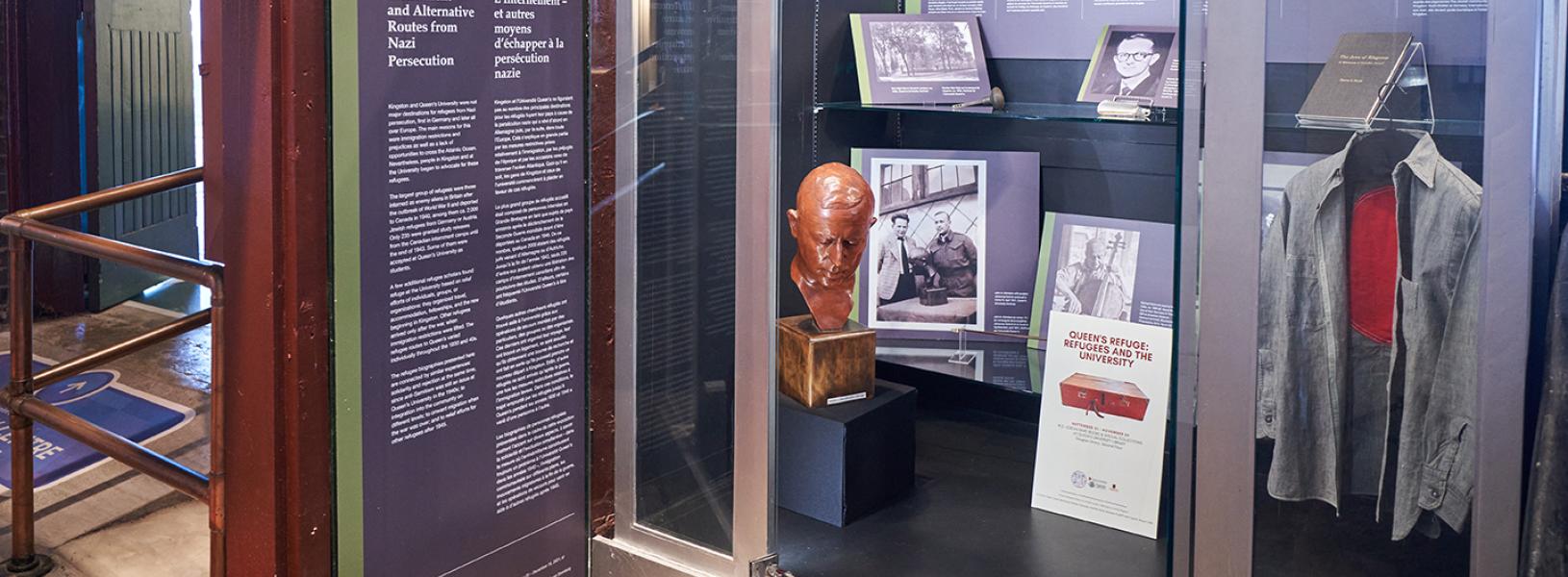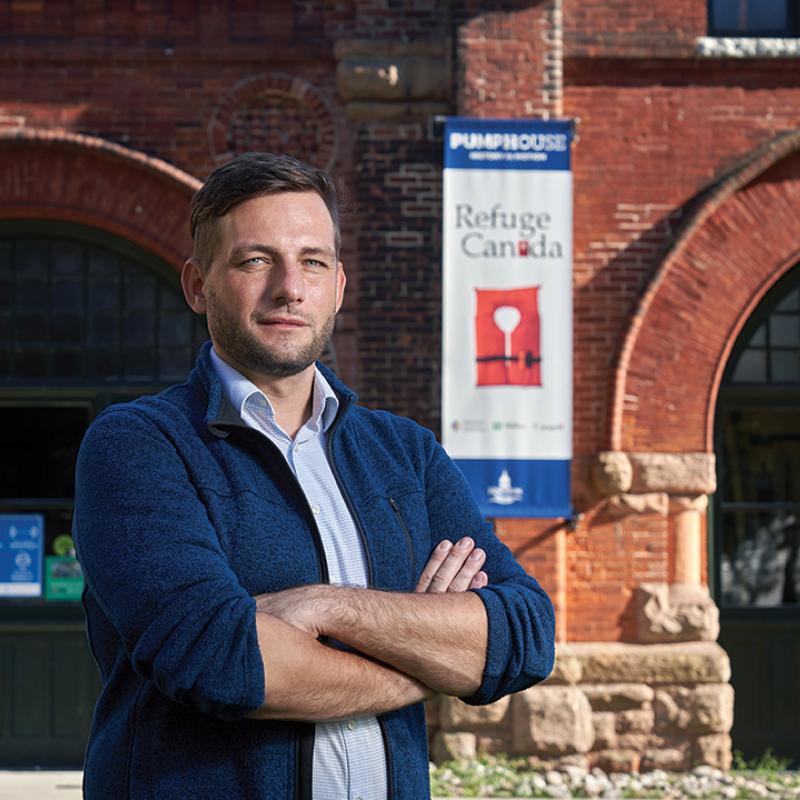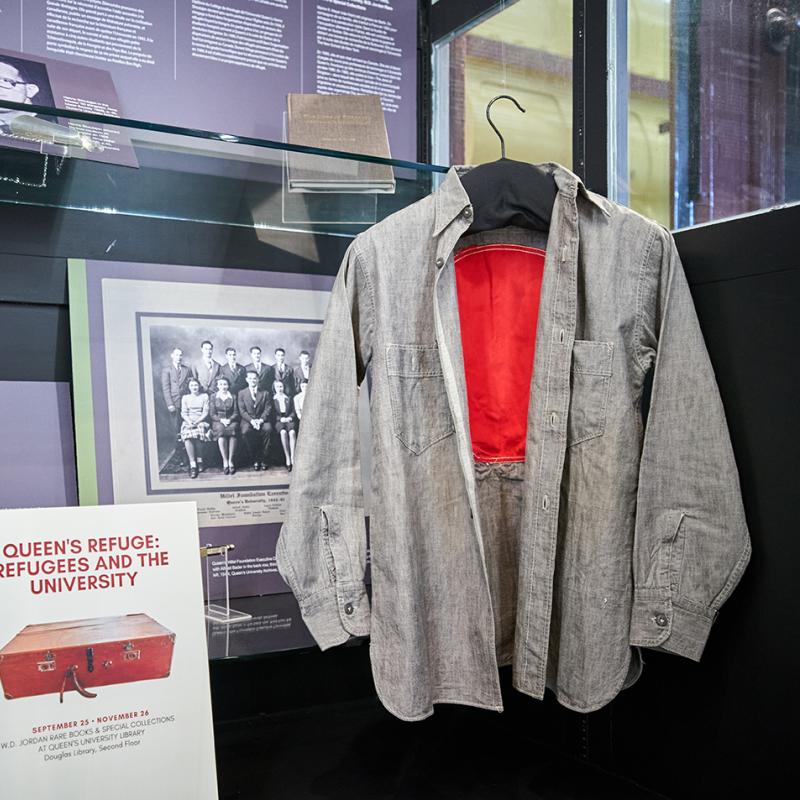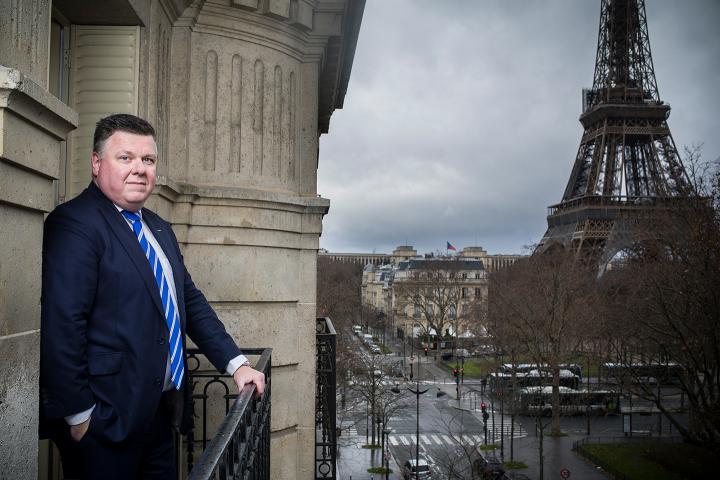We dress for success, comfort, style. But when a teenaged Alfred Bader put on his shirt each morning, he was dressing to become a potential target.
Dr. Bader – an illustrious Queen’s graduate and benefactor who was born in 1924 and died in 2018 at age 94 – left his native Austria for England in 1938 when he was just 14, one of thousands of mostly Jewish children escaping Nazi persecution in Germany and German-annexed countries through the Kindertransport program. Two years later, along with many other Jewish refugees as well as Nazi POWs, he was deported from England as an “alien enemy” and sent to an internment camp at Fort Lennox on Quebec’s Île aux Noix. Canadian officials failed to distinguish between the refugees and the POWs, and everyone, including the young Alfred, was issued a grey shirt with a large red dot on the back. Attempt to escape and you would become an easy target for the armed guards.
Dr. Bader’s shirt, which he kept for decades and which was given to Queen’s in 2019, is part of a university satellite exhibit at Kingston’s Pump-House Steam Museum that runs until Nov. 26. The exhibit explores forced migration through the stories of six people, including Dr. Bader, who would go on to forge such a strong connection with Queen’s. It’s part of both Refuge Canada, a travelling exhibit now at the PumpHouse, and Queen’s Refuge: Refugees and the University, an exhibit at the Douglas Library’s W.D. Jordan Rare Books and Special Collections. That exhibit, also on until Nov. 26, features individual artifacts and biographies that tell the story of forced migration in the history of Queen’s University and within the Queen’s community.
The Queen’s Refuge exhibit also tied into a biennial conference of the North American Society for Exile Studies at the university in September.
The shirt embodies and preserves for subsequent generations what everyday life was like in the Quebec camp, according to Swen Steinberg, a post-doctoral researcher in Queen’s Department of History who co-ordinated both Queen’s exhibits. It also stands for the experience of many other refugees and was so meaningful to Bader that he held on to it for years, says Dr. Steinberg.
“As someone who organizes this kind of exhibition, this is what you wish for.”
In 1941, Alfred Bader left Fort Lennox for Montreal, sponsored by Martin Wolff. Mr. Wolff encouraged Dr. Bader to pursue his education. After being rejected by McGill University because its Jewish “quota” had been filled and by the University of Toronto because it was doing sensitive war work, Alfred Bader was accepted into Queen’s Faculty of Applied Science.
“I was a free man, I had been welcomed into a Canadian family and had been accepted by a prestigious Canadian university,” he wrote in his autobiography. “I was determined to do my best.”
A lifelong devotee of both science and the arts, he rapidly completed a BSc in engineering chemistry, a BA in history, and an MSc in chemistry at Queen’s. A PhD in organic chemistry at Harvard followed in 1950.
Within a year of leaving Harvard, Dr. Bader co-founded the U.S.-based Aldrich Chemical Company. The company began life in a garage and became highly successful, eventually merging with another business and making Dr. Bader’s original stake worth hundreds of millions of dollars by the time he was forced out in a corporate upheaval in the early 1990s.
Through all this time, he hung on to the shirt, a tangible memory of a period in his life that he had, with the support of Mr. Wolff, Queen’s, and others, ultimately used as the launch pad for a new and remarkable life in North America.
That life included extensive philanthropy, much of it directed toward Queen’s. He endowed awards, scholarships, and faculty positions. In 1993, he and his wife, Isabel Bader, funded the purchase of the 15th-century Herstmonceux Castle in England to serve as the International Study Centre (later named for the couple). The Baders also generously supported the Isabel Bader Centre for the Performing Arts, and donated more than 500 paintings, sculptures, and various other works spanning the 14th to mid-19th centuries to the university’s Agnes Etherington Art Centre (the Bader Collection now stands as the most comprehensive Canadian collection of authenticated paintings by Rembrandt).
Dr. Bader had died by the time his shirt, which had been on exhibit at the Vancouver Holocaust Education Centre, arrived at Queen’s.
“He would have been pleased that Queen’s has it,” says Isabel Bader, who offered the shirt to the university. “Queen’s meant so much to Alfred, and this is a chance to share something about the experiences of Jewish war refugees.”
It also represents the complex depth of war refugees’ experience, says Brendan Edwards, curator of the W.D. Jordan Rare Books and Special Collections and a team member for the Queen’s Refuge exhibit. When the authorities realized the refugees at Fort Lennox were not POWs, a patch was issued so the refugees could cover the red dot, he says. Some also wore the shirt inside out, further concealing the dot, “but it’s still next to your skin.
“It creates a complexity that’s so valuable. When you’re studying history, it’s not straightforward.”
For Dr. Steinberg, artifacts and exhibits never tell the whole story. Instead, they offer ways into a larger narrative. He says migration, including forced migration, is part of human history, and Dr. Bader’s story is an opportunity to reflect on how we respond, or don’t respond, to refugees.
“[That’s] what this exhibition is about: it’s about us.”




